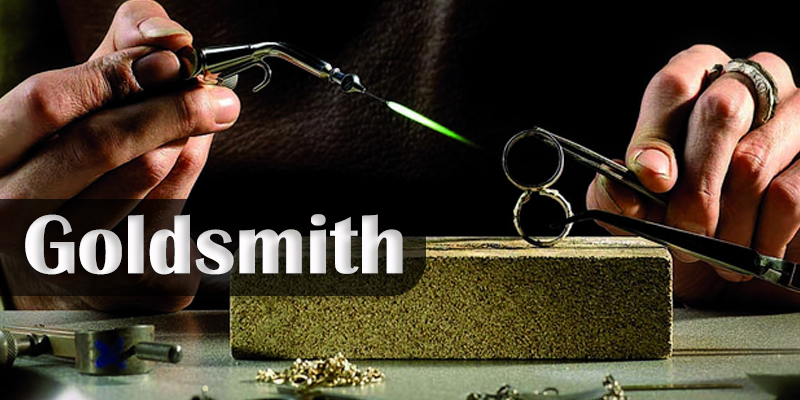iti
17 April 2025

ITI Gold Smith Syllabus (English)
Course Overview
- Trade Name: Gold Smith
- Duration: 1 Year (2 Semesters)
- NSQF Level: Level 4
- Eligibility: 8th Grade Pass
- Objective: To train candidates in designing, crafting, repairing, and polishing gold jewelry, preparing them for roles as goldsmiths, jewelry makers, or quality inspectors in jewelry workshops, retail, or manufacturing units, or for self-employment in jewelry crafting businesses.
- Certification: National Trade Certificate (NTC) by NCVT
Detailed Syllabus
Semester 1
Trade Theory
- Introduction to Gold Smithing: History, scope, and importance of gold jewelry in India; career prospects.
- Metals and Alloys: Properties of gold, silver, copper; karat system, alloying for jewelry (18K, 22K).
- Tools and Equipment: Files, pliers, hammers, anvils, blowtorches; types, uses, and maintenance.
- Jewelry Making Techniques: Casting, rolling, drawing, soldering; basic processes and applications.
- Safety Practices: Handling hot metals, chemicals (acids, fluxes), PPE (gloves, goggles), fire safety.
- Design Fundamentals: Elements of jewelry design (symmetry, balance), sketching motifs, hallmarking basics.
- Gemstones: Types (ruby, emerald, diamond), properties, identification, and setting methods.
Trade Practical
- Tool Handling: Practicing with files, pliers, saws; sharpening and maintaining tools.
- Metal Preparation: Melting and alloying gold with copper/silver; rolling into sheets or wires.
- Basic Techniques: Cutting, filing, and shaping gold sheets for simple designs (rings, bangles).
- Soldering: Joining gold pieces using blowtorch and flux; ensuring strong joints.
- Safety Drills: Using PPE, handling chemical spills, practicing fire extinguisher use.
- Design Practice: Sketching basic jewelry designs (pendants, earrings) on paper.
- Project Work: Crafting a simple gold ring or pendant with proper finishing and polishing.
Hours: Theory: 160 hours | Practical: 240 hours
Semester 2
Trade Theory
- Advanced Jewelry Techniques: Engraving, embossing, filigree, granulation; applications in traditional/modern designs.
- Stone Setting: Prong, bezel, pave, channel settings; techniques and tools.
- Jewelry Repair: Fixing broken chains, resizing rings, replacing clasps, restoring worn jewelry.
- Polishing and Finishing: Buffing, electroplating, rhodium coating; achieving high-quality shine.
- Quality Control: Inspecting jewelry for defects, testing gold purity, understanding BIS standards.
- Entrepreneurship: Starting a jewelry workshop, costing materials, market trends in gold jewelry.
- Environmental Practices: Managing chemical waste, recycling metal scraps, safe disposal of acids.
Trade Practical
- Advanced Techniques: Practicing engraving and filigree on gold pieces; creating textured designs.
- Stone Setting: Setting semi-precious stones (e.g., garnet, amethyst) in rings or pendants.
- Repair Work: Repairing broken gold chains, resizing bangles, soldering new clasps.
- Polishing: Buffing jewelry to mirror finish; applying rhodium coating to sample pieces.
- Quality Checks: Testing jewelry for purity using touchstone, inspecting for craftsmanship flaws.
- Field Exposure: Hands-on training in jewelry workshops or retail stores (2-4 weeks).
- Project Work: Designing and crafting a complete gold jewelry piece (e.g., necklace with stone setting) with polishing and quality analysis.
Hours: Theory: 160 hours | Practical: 240 hours
Additional Components
- Workshop Calculation and Science
- Calculations: Gold weight conversion (grams to carats), alloy proportions, costing jewelry.
- Science: Metallurgy of gold, chemical reactions in soldering, heat effects on metals.
- Hours: 40 hours/year
- Employability Skills
- Communication: Interacting with clients, presenting designs, teamwork.
- IT Literacy: Using design software (e.g., CAD basics), online market research for jewelry trends.
- Soft Skills: Time management, resume writing, interview preparation.
- Hours: 60 hours/year
Assessment and Certification
- Exams:
- Theory: Written exams per semester (MCQs, descriptive questions).
- Practical: Tasks like crafting jewelry, stone setting, repair, and polishing.
- Evaluation Criteria: Craftsmanship precision, design creativity, safety practices, quality control.
- Certification: NCVT National Trade Certificate (NTC) upon passing both semesters, globally recognized.
Career Opportunities
- Employment: Goldsmith, jewelry maker, quality inspector in jewelry workshops, retail stores, or manufacturing units.
- Self-Employment: Jewelry crafting business, freelance designer, gold repair services.
- Further Studies: Diploma in Jewelry Design, certifications in gemology, or entrepreneurship courses.
Trade Type
- 22 views